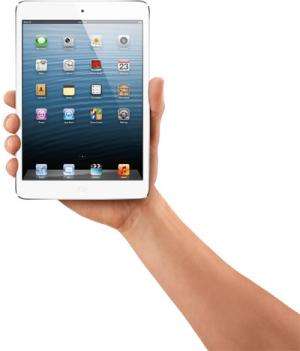Review: Despite upgrades, iPad Mini not worth Apple's premium

The iPad Mini is a device I'd like to love.
At first glance, the gadget would appear to be everything I'd want in a tablet. It comes with Apple Inc.'s iOS software and can run the hundreds of thousands of iPad apps. But it's more portable and less expensive than the full-sized iPad.
And the new version, which Apple started shipping in limited quantities last month, fixes the two biggest technical problems of the original iPad Mini, which Apple released last year. The new model has a high-resolution display and Apple's latest - and fastest - mobile processor.
So what's not to like?
Well, the biggest thing is its price. Apple took a device that already cost much more than its competitors and upped its price tag significantly. Considering that both Google Inc.'s Nexus 7 or Amazon.com Inc.'s Kindle Fire HDX also are much improved from last year, it's hard for me to recommend that you spend $170 more for an iPad Mini.
The new Mini looks and feels a lot like last year's version. It has the same shape, height and width and the same size screen. It's slightly thicker and heavier than last year's model, but not so much that you'd likely notice. The aluminum back of the black model is a bit lighter in color than last year, but again, the change is subtle.
I liked the design of last year's model - although I wished it were a bit thinner - and I'm of the same mind about this year's version.
The big change that you'll notice is the new Mini's display. Last year's relatively low-resolution screen has been replaced with Apple's so-called Retina high-resolution display.
In terms of pixel per inch - the common measurement for screen resolution - the new Mini's display is equal to that in the iPhone 5S and is superior to that in Apple's full-sized iPad. It's super-sharp and makes reading books or Web pages or watching high-definition movies a joy.
The screen does have one minor shortcoming, though. According to DisplayMate, a consulting firm that evaluates the screens in various computing devices, the range of colors the new iPad Mini can display is a fraction of the general color standard and significantly less than what can be displayed by the iPad Air or the Kindle Fire HDX. I noticed the difference when displaying the same pictures on an Air and on the new Mini; on the Mini, the colors sometimes looked a bit washed out.
But to my eyes the difference was small, and I couldn't see much of a difference at all when comparing scenes from movies such as "The Avengers," "Robots" and Pedro Almodovar's "Tie Me Up! Tie Me Down!"
The Mini's other big change is a much more powerful chip, Apple's A7 chip, which is two generations beyond the A5 chip that was in last year's model. In my tests, it ran many times faster than the previous chip.
You may not notice much of a difference on a day-to-day basis unless you are editing videos or playing games with complex graphics. But the new chip is much more future-proof than the old one; you'll likely be able to upgrade to the latest versions of iOS for much longer than you could have with the old Mini.
Other than those two changes, the Mini is basically the same as last year's model. It has the same cameras, and access to the same selection of apps. Both models - Apple is continuing to offer last year's version - now ship with iOS 7, the significantly revised operating system. And both versions have the same claimed battery life - about 10 hours on the Wi-Fi-only models.
At $300, the new Mini would be an excellent value. But its $400 price tag seems excessive, especially compared to the latest tablets running versions of Google's Android software. Many of those devices are well-designed and have access to many of the best tablet apps. Some also have options you can't get on the Mini, such as the ability to change the default Web browser or support for multiple users on a single device.
Those Android-based tablets that compete with the Mini tend to cost far, far less. Google's Nexus 7, for example, has a rocket-fast new chip, a screen that's as high-resolution as the Mini's, and a fine selection of available movies and apps. And it starts at just $230.
As impressive as the new Mini's screen and chip are, especially compared to last year, they just aren't worth that kind of difference in price.
APPLE IPAD MINI TABLET WITH RETINA DISPLAY:
-Likes: Speedy new processor; sharp high-resolution screen; access to large number and wide range of tablet applications; thin, lightweight design
-Dislikes: Expensive; screen displays a relatively narrow range of colors; doesn't support multiple-user log-ons
-Specs: 64-bit A7 chip; 7.9-inch, 2048 x 1536 pixel screen; 1.2-megapixel front and 5-megapixel rear cameras
-Price: For Wi-Fi only models, $400 for 16-gigabyte version, $500 for 32-gigabyte and $600 for 64-gigabyte. Models with cellular radios are $130 more at each storage size.
-Web: apple.com
©2013 San Jose Mercury News (San Jose, Calif.)
Distributed by MCT Information Services




















